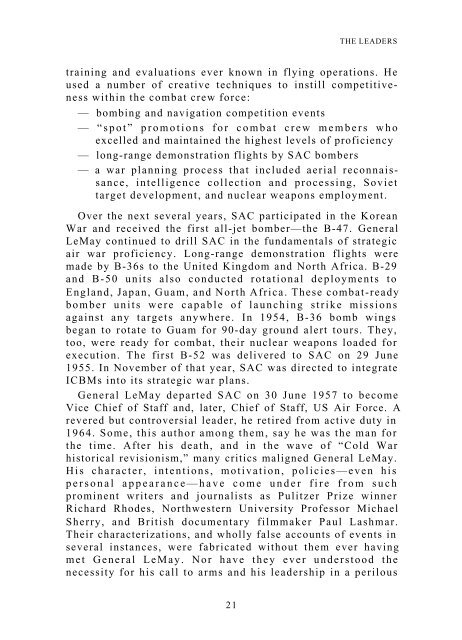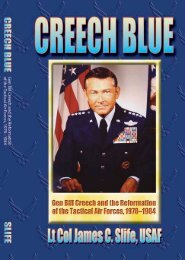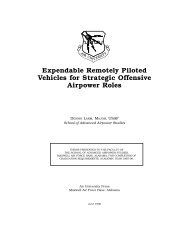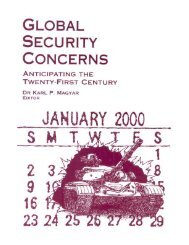Inside the Cold War - Project Gutenberg Consortia Center
Inside the Cold War - Project Gutenberg Consortia Center
Inside the Cold War - Project Gutenberg Consortia Center
You also want an ePaper? Increase the reach of your titles
YUMPU automatically turns print PDFs into web optimized ePapers that Google loves.
THE LEADERS<br />
training and evaluations ever known in flying operations. He<br />
used a number of creative techniques to instill competitiveness<br />
within <strong>the</strong> combat crew force:<br />
— bombing and navigation competition events<br />
— “spot” promotions for combat crew members who<br />
excelled and maintained <strong>the</strong> highest levels of proficiency<br />
— long-range demonstration flights by SAC bombers<br />
— a war planning process that included aerial reconnaissance,<br />
intelligence collection and processing, Soviet<br />
target development, and nuclear weapons employment.<br />
Over <strong>the</strong> next several years, SAC participated in <strong>the</strong> Korean<br />
<strong>War</strong> and received <strong>the</strong> first all-jet bomber—<strong>the</strong> B-47. General<br />
LeMay continued to drill SAC in <strong>the</strong> fundamentals of strategic<br />
air war proficiency. Long-range demonstration flights were<br />
made by B-36s to <strong>the</strong> United Kingdom and North Africa. B-29<br />
and B-50 units also conducted rotational deployments to<br />
England, Japan, Guam, and North Africa. These combat-ready<br />
bomber units were capable of launching strike missions<br />
against any targets anywhere. In 1954, B-36 bomb wings<br />
began to rotate to Guam for 90-day ground alert tours. They,<br />
too, were ready for combat, <strong>the</strong>ir nuclear weapons loaded for<br />
execution. The first B-52 was delivered to SAC on 29 June<br />
1955. In November of that year, SAC was directed to integrate<br />
ICBMs into its strategic war plans.<br />
General LeMay departed SAC on 30 June 1957 to become<br />
Vice Chief of Staff and, later, Chief of Staff, US Air Force. A<br />
revered but controversial leader, he retired from active duty in<br />
1964. Some, this author among <strong>the</strong>m, say he was <strong>the</strong> man for<br />
<strong>the</strong> time. After his death, and in <strong>the</strong> wave of “<strong>Cold</strong> <strong>War</strong><br />
historical revisionism,” many critics maligned General LeMay.<br />
His character, intentions, motivation, policies—even his<br />
personal appearance—have come under fire from such<br />
prominent writers and journalists as Pulitzer Prize winner<br />
Richard Rhodes, Northwestern University Professor Michael<br />
Sherry, and British documentary filmmaker Paul Lashmar.<br />
Their characterizations, and wholly false accounts of events in<br />
several instances, were fabricated without <strong>the</strong>m ever having<br />
met General LeMay. Nor have <strong>the</strong>y ever understood <strong>the</strong><br />
necessity for his call to arms and his leadership in a perilous<br />
21






